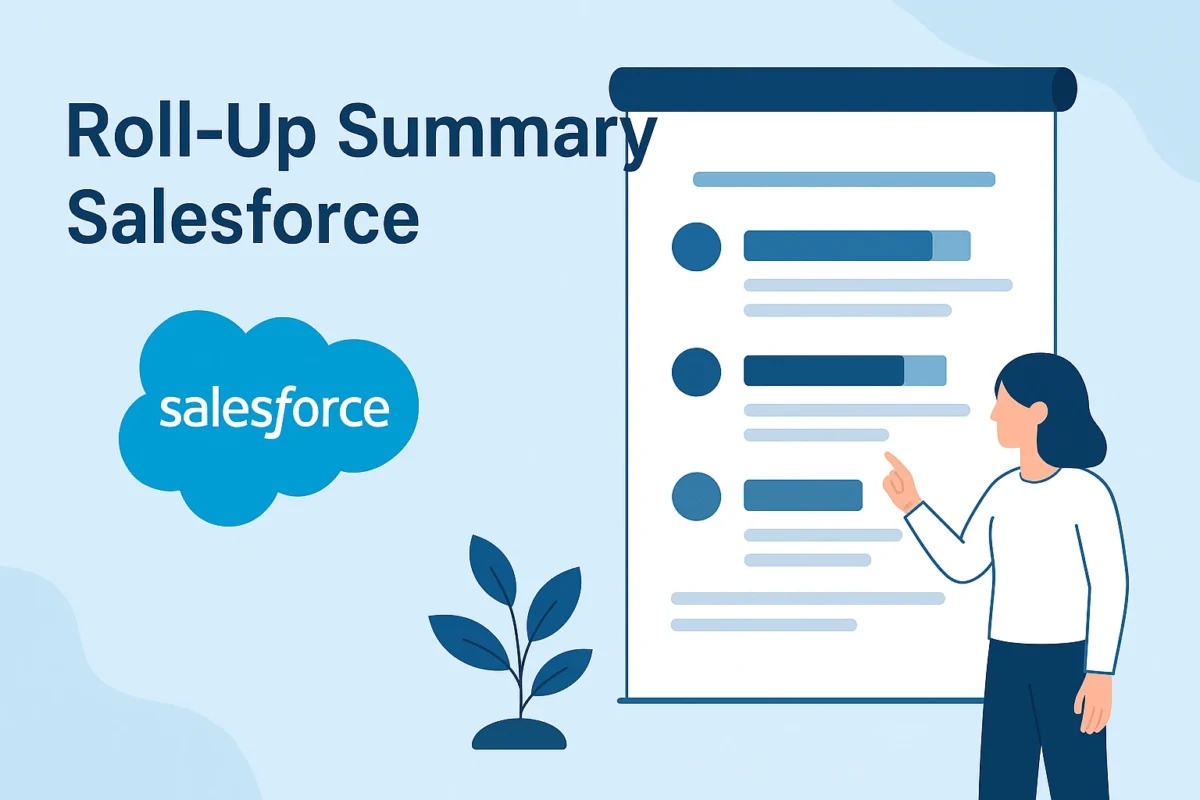
Roll up summary Salesforce fields are essential tools that allow users to automatically calculate values from related records, streamlining reporting and data analysis in Salesforce. Whether you’re working on a master-detail relationship or seeking workarounds for lookup relationships, understanding roll-up summaries can significantly improve your Salesforce architecture.
In this article, we’ll explore:
-
What is a roll-up summary in Salesforce?
-
How to create a roll-up summary field
-
Limitations and workarounds (including triggers and formula fields)
-
Usage in reports
-
FAQs to clarify common doubts
What is Roll Up Summary in Salesforce?
A Roll-Up Summary in Salesforce is a field type that performs calculations (SUM, MIN, MAX, COUNT) on child records and displays the result on the parent record. It is only available for Master-Detail relationships.
✅ What is Roll Up Summary Field in Salesforce?
A Roll Up Summary Field in Salesforce allows you to summarize data from a child object into the parent object. For example, you could create a roll-up summary to calculate the total value of all opportunities associated with an account.
How to Create Roll Up Summary Field in Salesforce
Here’s a step-by-step guide:
-
Navigate to Object Manager
-
Go to Setup → Object Manager → Choose the parent object.
-
-
Create a New Field
-
Click on Fields & Relationships → New → Select Roll-Up Summary.
-
-
Choose Summary Type
-
Pick the child object and select the summary type: COUNT, SUM, MIN, or MAX.
-
-
Apply Filter Criteria
-
Optionally, apply filters to include only certain records in the calculation.
-
-
Save and Add to Page Layout
Roll Up Summary for Lookup Relationship Salesforce
Native roll-up summaries are not available for Lookup relationships. However, you can achieve this with:
-
Apex Triggers: Custom code that calculates and updates the parent record.
-
Flow + Scheduled Path: Use Salesforce Flow to simulate roll-up behavior.
-
AppExchange Tools: Use apps like DLRS (Declarative Lookup Rollup Summaries) for no-code options.
Roll Up Summary Using Trigger in Salesforce
If you need a roll-up on a lookup relationship, here’s a simple Apex Trigger example:
This counts the number of contacts for each account and stores it in a custom field.
Salesforce Roll Up Summary on Formula Field
Roll-up summary fields cannot directly summarize formula fields with references to other objects.
Workarounds:
-
Use a trigger to calculate the value.
-
Store the formula result in a regular field using Flow.
-
Flatten your data model to avoid cross-object references.
Roll Up Summary Field in Report Salesforce
While roll-up summary fields are not report-specific, you can include them in Salesforce reports to display aggregated data at the record level. Just ensure the roll-up field is added to the object’s page layout and is reportable.
Roll Up Summary Fields Limitations Salesforce
Here are some key limitations:
-
Only available on Master-Detail relationships
-
Cannot roll up formula fields that reference other objects
-
Limited summary operations (only COUNT, SUM, MIN, MAX)
-
No support for Lookup relationships without custom solutions
-
Limited to 10 roll-up fields per object (can vary with edition)
Roll Up Summary Formula Field Salesforce
You can use formula fields to enhance your roll-up summaries. For instance, calculate the average by dividing the total (SUM) by count (COUNT) using a formula field on the parent.
Example:
FAQs: Roll Up Summary Salesforce
Q1. What are the types of roll-up summary fields in Salesforce?
Answer: COUNT, SUM, MIN, and MAX.
Q2. Can we create roll-up summaries for lookup relationships?
Answer: Not directly. You need to use Apex Triggers, Flow, or tools like DLRS.
Q3. Can roll-up summary fields summarize formula fields?
Answer: Only if the formula field does not reference other objects.
Q4. How many roll-up summary fields can we create?
Answer: Typically up to 10 per object, but it may vary by Salesforce edition.
Q5. Is roll-up summary field data real-time?
Answer: Yes, it updates automatically when child records change.
Conclusion
Understanding how to use Roll Up Summary Salesforce fields is essential for any Salesforce administrator or developer. They simplify data management, provide critical insights, and eliminate the need for manual calculations.
If you’re dealing with lookup relationships or want to work around limitations, custom Apex or DLRS tools can be your best allies.

